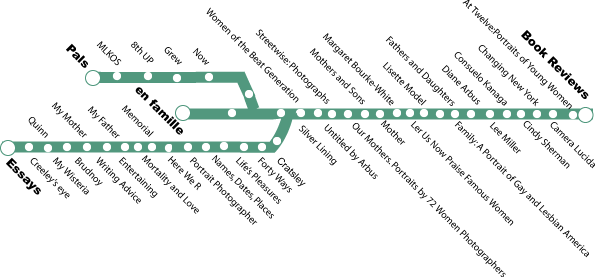 The camera is a very large rectangular box, with lens and black cloth
bellows at the front. Using Polacolor Polaroid film, it makes brilliantly colored photographs that are twenty inches by twenty four inches in seventy-five seconds. Built into the back, the motorized Polaroid processor has rollers that squeeze and spread chemicals onto positive and negative paper. There are two doors: one where the bellows are attached to insert pods of chemicals and rolls of positive and negative, and another at the back covering the viewing glass that the photographer looks through. It weighs 200 pounds and is perched on a dolly so it can be cranked up and down and rolled around. The processing system works like the old "peel apart" Polaroids of the fifties and sixties--after seventy-five seconds,the positive image is ready to be peeled apart from the negative. Happily, the image doesn't have to be coated. This camera runs like a dream when I am relaxed and jams when I am anxious. When I am overtired or upset, its motor comes to a grinding halt.
The camera is a very large rectangular box, with lens and black cloth
bellows at the front. Using Polacolor Polaroid film, it makes brilliantly colored photographs that are twenty inches by twenty four inches in seventy-five seconds. Built into the back, the motorized Polaroid processor has rollers that squeeze and spread chemicals onto positive and negative paper. There are two doors: one where the bellows are attached to insert pods of chemicals and rolls of positive and negative, and another at the back covering the viewing glass that the photographer looks through. It weighs 200 pounds and is perched on a dolly so it can be cranked up and down and rolled around. The processing system works like the old "peel apart" Polaroids of the fifties and sixties--after seventy-five seconds,the positive image is ready to be peeled apart from the negative. Happily, the image doesn't have to be coated. This camera runs like a dream when I am relaxed and jams when I am anxious. When I am overtired or upset, its motor comes to a grinding halt.
The 20x24 was designed by Edwin H. Land, the inventor and founder of Polaroid. Only five were built-- hand made in Dr. Land's personal workshop. The first one was unveiled at a Polaroid stock holders meeting in April 1976. In my view, the camera represents a special time in corporate American history when the founder of a public company could build a product with few commercial applications simply because he wanted to. There were no bottom line considerations. All but one of the skilled machinists who tooled the 20x24 have retired and have not been replaced. The machine shop where the cameras were built is quiet now. Spare parts were never made and patterns for parts, if they ever existed, were misplaced long ago.
Almost twenty years before Dr. Land unveiled the 20x24, I graduated from Tufts University in Medford, MA. In 1959 most girls like me were going to be elementrary school teachers and I didn't want to be one. I wanted to be a writer. I went to New York City where I got a job at Grove Press. It was the pivotal experience of my life. I was secretary to Dick Seaver, the managing editor of the Press and The Evergreen Review,and typed letters to Henry Miller, Samuel Beckett, Jasper Johns. As part of my job I arranged the first poetry readings of the sixties with Allen Ginsberg, Charles Olson and Robert Creeley. I was a handmaiden and I considered it a more than adequate role. The thought that I was leading a vicariously creative life by helping these men never occurred to me--even after I formed the Paterson Society to arrange poetry readings at colleges across the country and to publish small books of their poetry.
Find Elsa's Books
Please change your links and bookmarks to elsadorfman.com!
Elsa thanks her cybergodmother, photo.net, her longtime, most generous host at furfly.com, and her current web host Mike Sisk at TCP/IP Ranch, LLC.
Copyright 1970-2010 © Elsa Dorfman.
Inquiries for the use of Elsa's content are welcomed!
Please
read these guidelines.
Contact
Elsa Dorfman via email or send Website Feedback to her webmaster.






